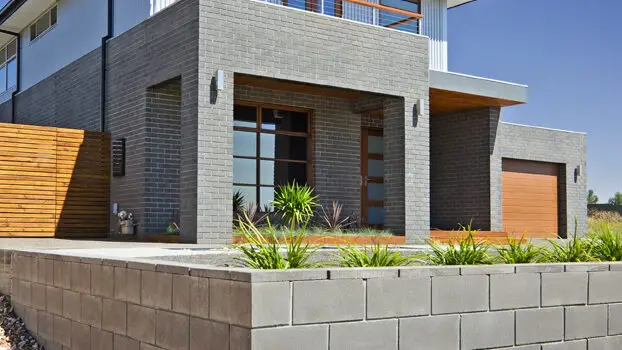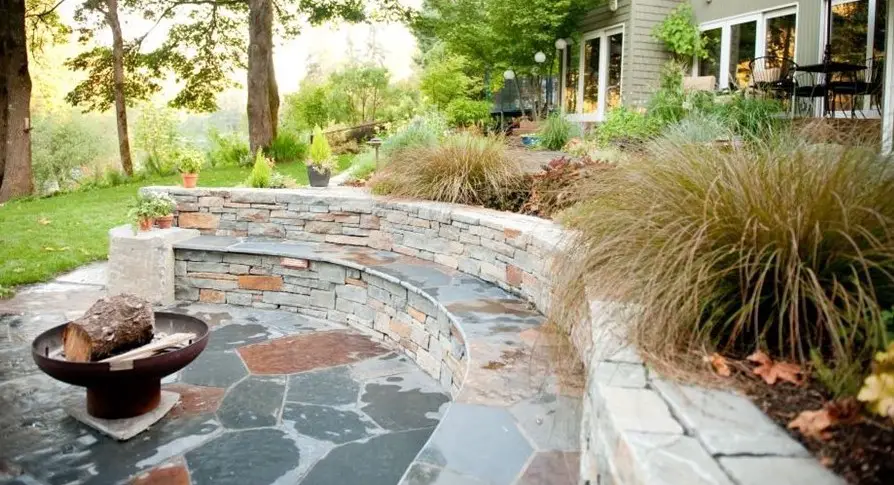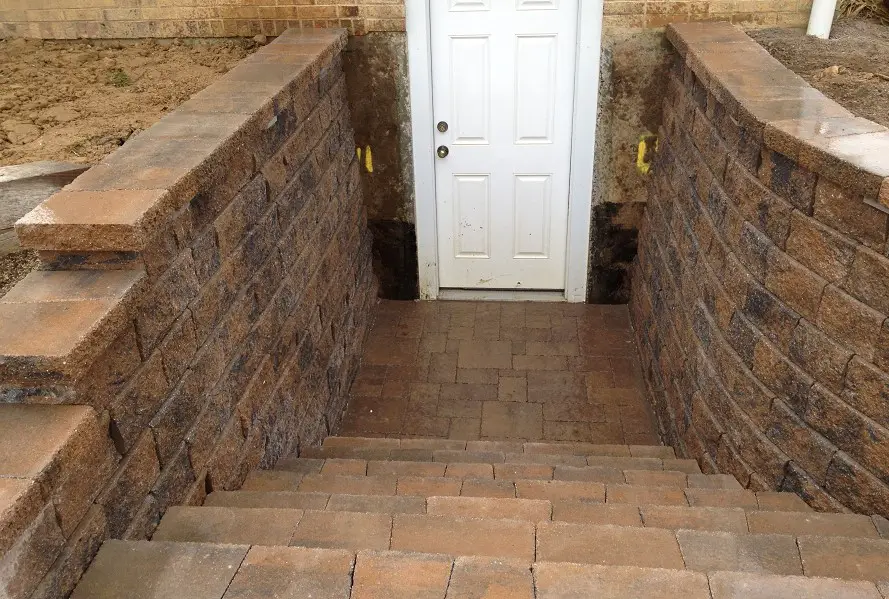What does your walkout basement outdoor area have in common with Ancient Egypt? It’s a particular type of wall: retaining walls.
Then and now, they are transforming in a tremendous way everything they are applied to. We aren’t going to use a retaining wall to correct the course of the Nile, but shaping your basement walkout area this way is about just as amazing.
Let’s look at some ideas for walkout basement retaining walls. Whether you are landscaping around your walk-out patio to add privacy there, or zoning between your back and front yard, you can combine any wall ideas to create an amazing, peaceful place outside your basement.

Contents
- 1 Brick retaining wall
- 2 Versatile block retaining walls
- 3 Poured concrete retaining walls
- 4 Stone retaining walls
- 5 Basement retaining wall made of caged rocks
- 6 Wood wall: retaining walls with a rustic touch
- 7 Seated retaining wall
- 8 Basement retaining wall with stairs
- 9 Some extra basement retaining wall features
- 10 A few tips
- 11 FAQs
- 12 Conclusion
Brick retaining wall
A walk-out framed in a brick retaining wall is classic. Constructed by professionals, retaining walls made of bricks last very long. Also, bricks can be painted, so you can choose to stick with no paint, go for classic beige walls, or play with color.

Versatile block retaining walls
Blocks are usually cheaper and larger than bricks, and you can go with less masonry expertise, time, and plaster needed to install a walkout wall.
Retaining walls made of cheap cinder blocks are light, while concrete/stone blocks create enough pressure to hold soil of any density.
If you have an existing walkout basement, and a retaining wall is optional, try lego-style interlocking wall blocks. It’s one of the easiest ways to build a retaining wall (well, if you can use a circular saw). Interlocking retaining walls don’t rely on plaster to stay in place.

Poured concrete retaining walls
Concrete gray walls might be too dull for some landscapes, but for others this seamless industrial urban look is perfect. To be a success, a concrete basement retaining wall is better to be built by professionals.
And if your walkout basement is so underground that you need a compact entrance with stairs, concrete retaining walls around it are the best.
Also, though you can’t go wrong with a plain gray floor basement idea for a walkout path, you can add fake stone finishing to the walls here, like the one on your stone fireplace. Or even lay tiles to coordinate with the pool area.

Stone retaining walls
If you are going to honor mother nature by imitating it, go with stone retaining walls. Dry stacked stone walls can only be three feet high, but they drain very well compared to the “real” masonry work. You can purchase or collect the stones for your retaining wall. Retaining walls like this don’t even need mortar or concrete to stay intact.

Basement retaining wall made of caged rocks
Want stones for walkout borders, but without masonry? Have a pile of rocks in reach? Pack them tightly into a chicken wire net or a cage made of welded wire mesh, and make a low retaining wall. Simple idea, but make sure the metalwork is sturdy, or there might be a disaster in place of your retaining wall one day.

Wood wall: retaining walls with a rustic touch
Even though wood doesn’t have the best durability for a basement retaining wall, retaining walls made of it can turn a walk-out area into a cozy nest-like corner.
Go for new timber with sleek finishing and rich dark tones to define the borders of a modern-looking walk-out zone.
And for a rustic vibe or weathered look, install a railroad tie retaining wall. Usedwooden railroad ties are harder to come by day by day, but it’s a tremendous way to give your yard character while keeping the project humble.

Seated retaining wall
It is always nice to sit for a while on your lovely walk-out patio, and a retaining wall that reaches the height of a bench can easily be one. Your home and life will only benefit from an improved yard – which is why you must make a seated retaining wall if you can. Just add a surface where you can sit, or plan for it from the start.

Basement retaining wall with stairs
Add stairs to a retaining wall to expand the walkout zone with easy-to-access levels. Stairs connect the walkout area with the rest of the lot, but they need more attention to proper drainage than a basement retaining wall itself. Pressure from walking wears the stairs first if they are constantly wet.

Some extra basement retaining wall features
Retaining wall garden. You flesh out any garden ideas with retaining walls, some of which are even vertical. No limits here.
Decorative terraced retaining wall.
Turning your slope into a fancy feature can be done by splitting your lot into multiple sections with layered terraced retaining walls.
Built-in lighting. If you want to define zoning in your lot more and enjoy the outdoors after dark, add built-in lighting to your retaining walls.

A few tips
Choose materials you can work with to build a wall. Retaining walls can be a high-end professional project but often they don’t have to. Try to keep it simple.
Keep the wall level, especially the foundation. An uneven retaining wall can be a massive eye sore, but there’s more to it: it affects sturdiness. Don’t go sloppy with this while constructing a basement retaining wall, leveling of layers is crucial.
Keep the retaining wall dry. Failing to provide enough drainage can destroy any basement retaining wall. Retaining walls might require installing french drainage if you can’t get by with just proper planning and placement.

FAQs
What is the ideal slope for a walkout basement?
Unless you already have a correct inclination on your lot, your walkout basement house plans must include enough space for proper sloping to prevent drainage problems. A minimum of a 15-20% slope from front to back is optimal, while more increase is not worth the growing construction costs.

Which retaining wall is best for a basement?
There is no one strict rule for basement retaining wall materials, but if you deal with soft soil, use rigid ones that can hold the ground in place at all times. And if you build on stiff soil, there are no restrictions on what materials you use.

What are the disadvantages of a walkout basement?
While the pros of having a walkout basement outnumber the cons, the downsides of it aren’t so small. They include high construction costs and taxation, risks of leaking and flooding, as well as your basement entry being an obvious target for ill-willed intruders.

Are walkout basements worth more?
Yes. Walkout basements expand your living space. Functionally, a walkout basement is closer to being an extra floor in your house than a basement, and this feature can add up to 10% to the market worth of the house.
Conclusion
Your ideal basement walkout area will likely have more than one retaining wall, as they give structure to the outdoors around your walkout basement. Retaining walls can do much more than protect your basement and keep soil from erosion: they create a beautiful peaceful place that your family will surely love.
Read More: How To Create An Amazing Walkout Basement



